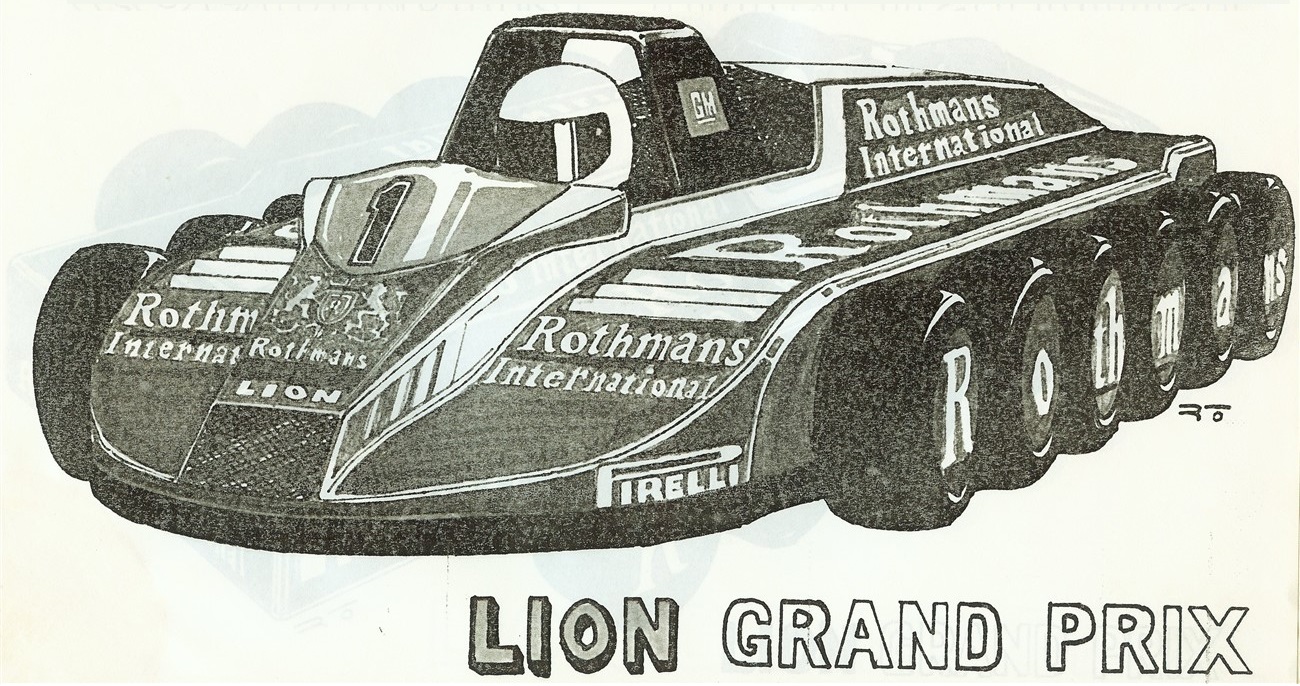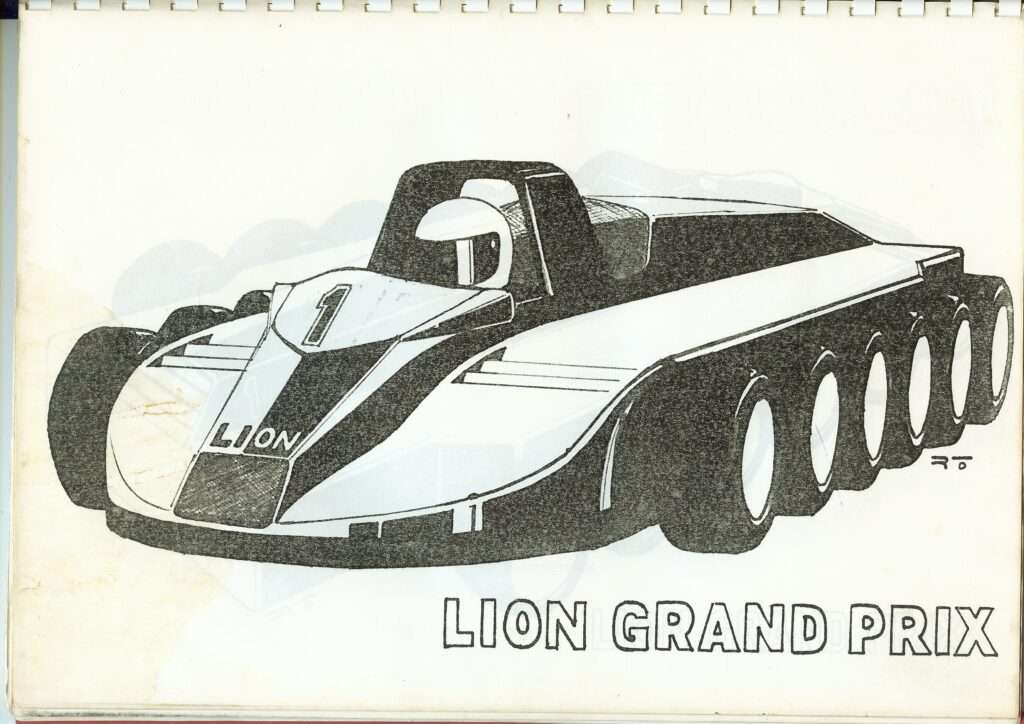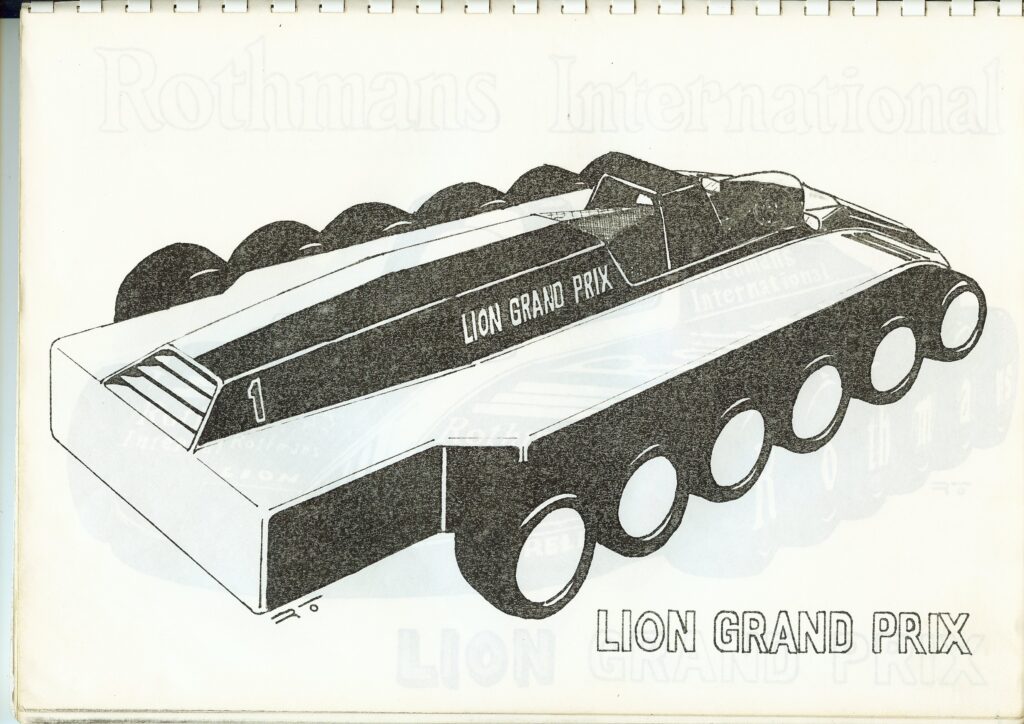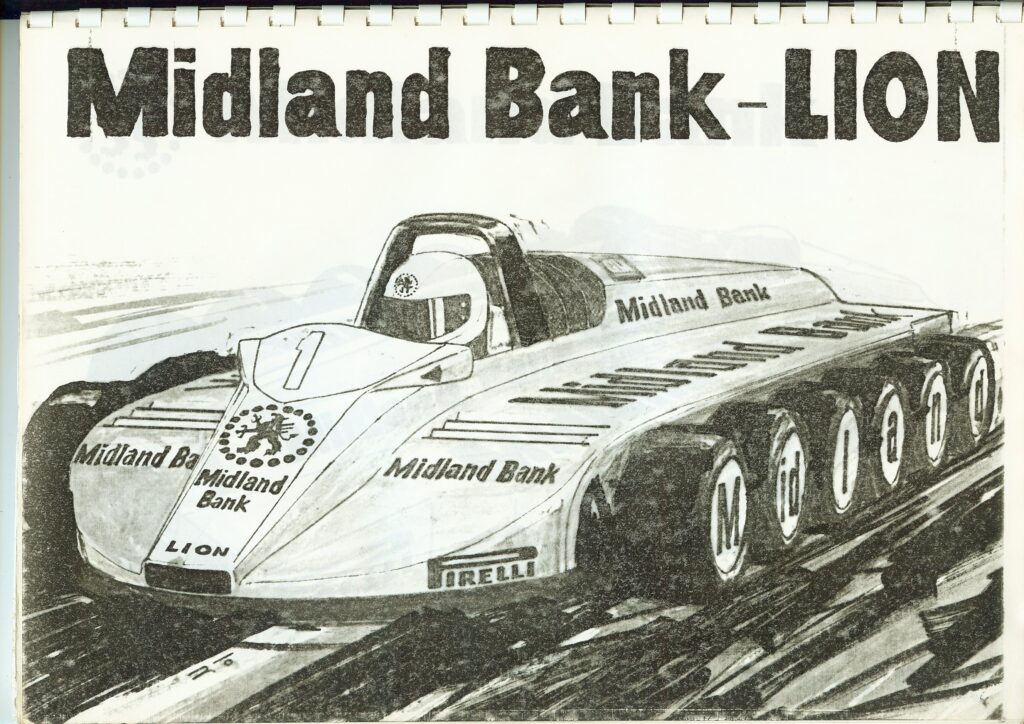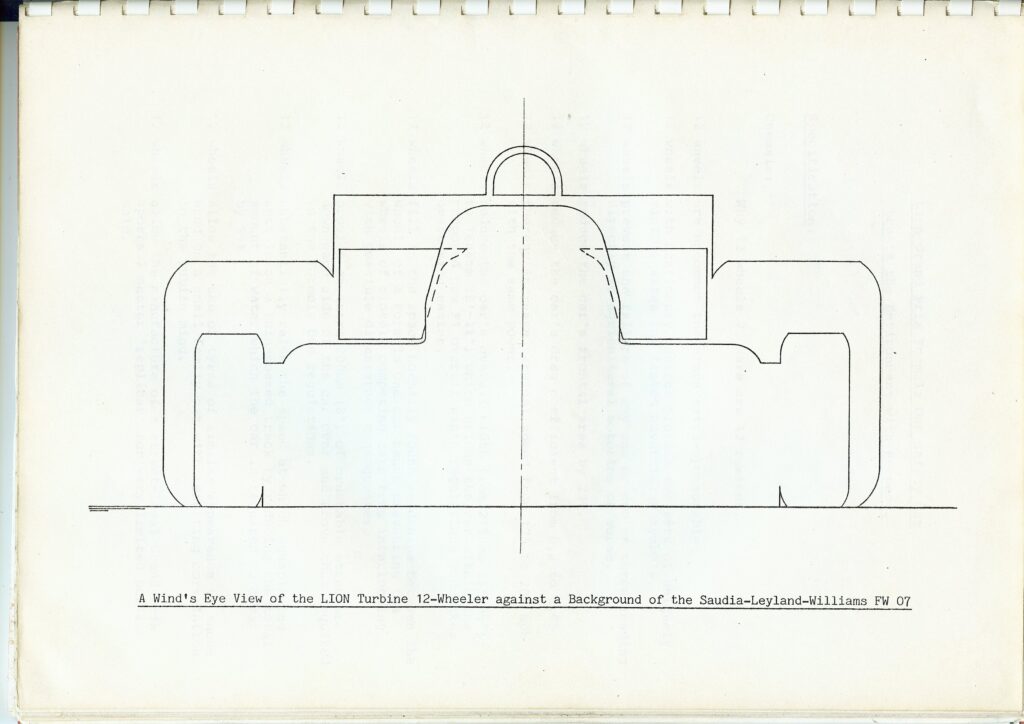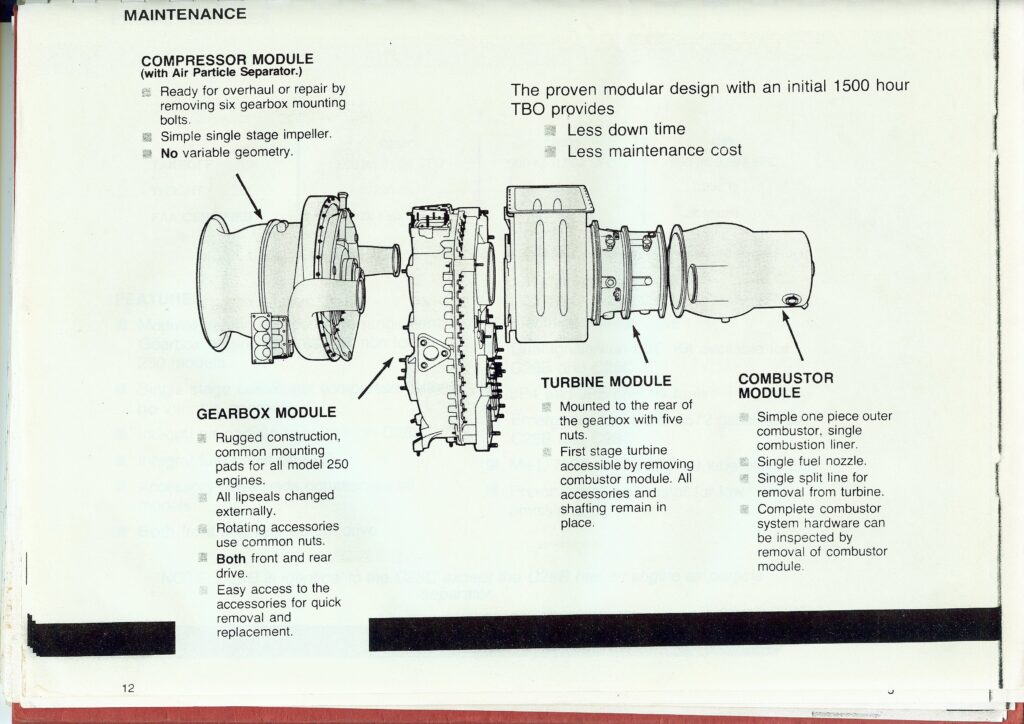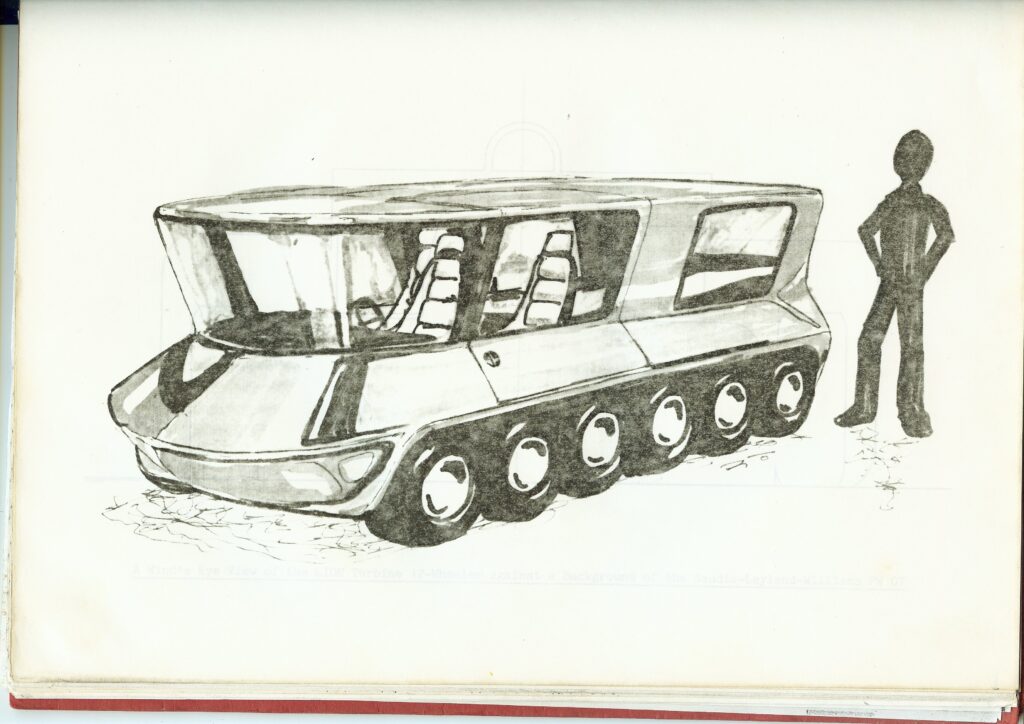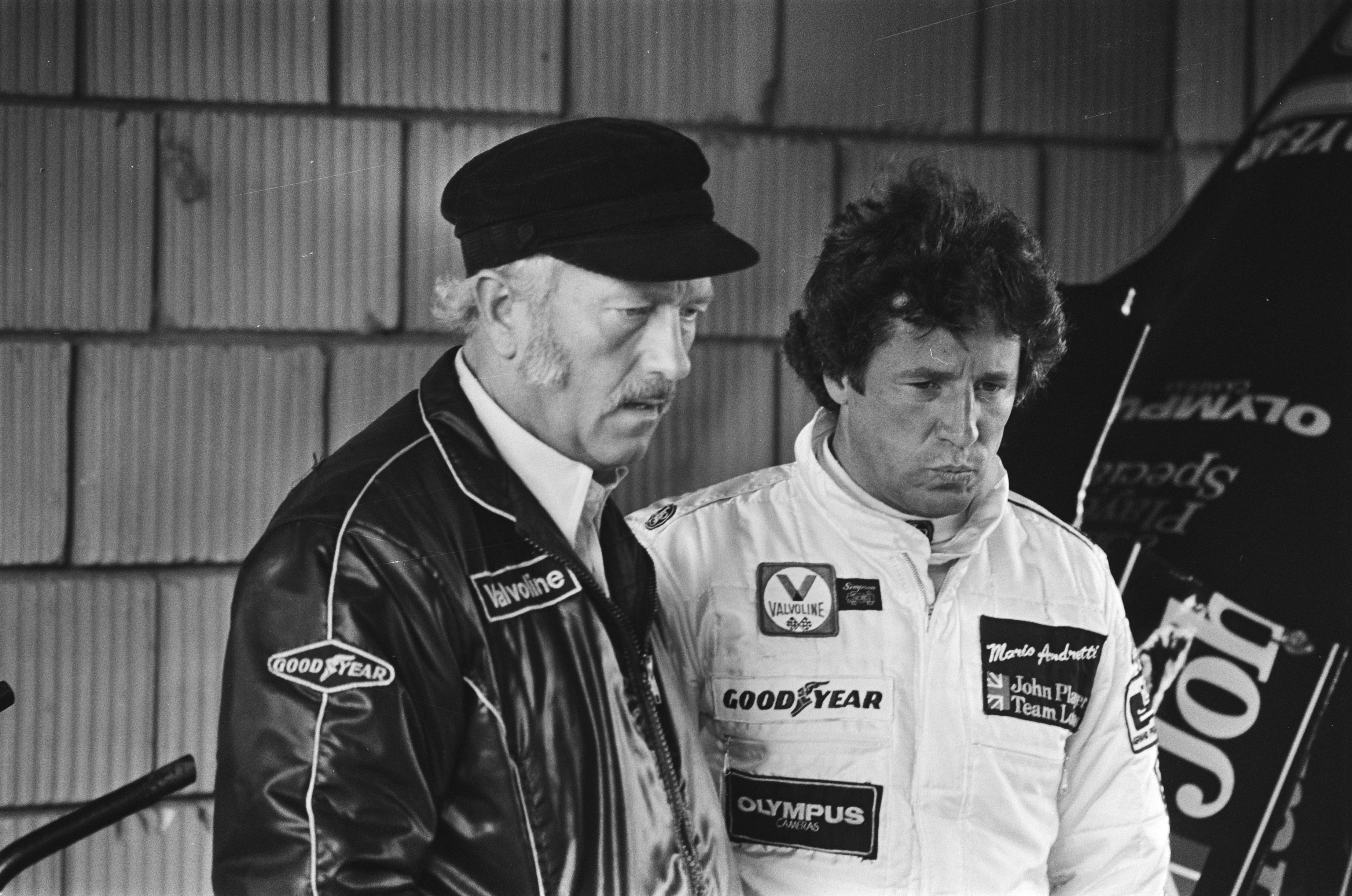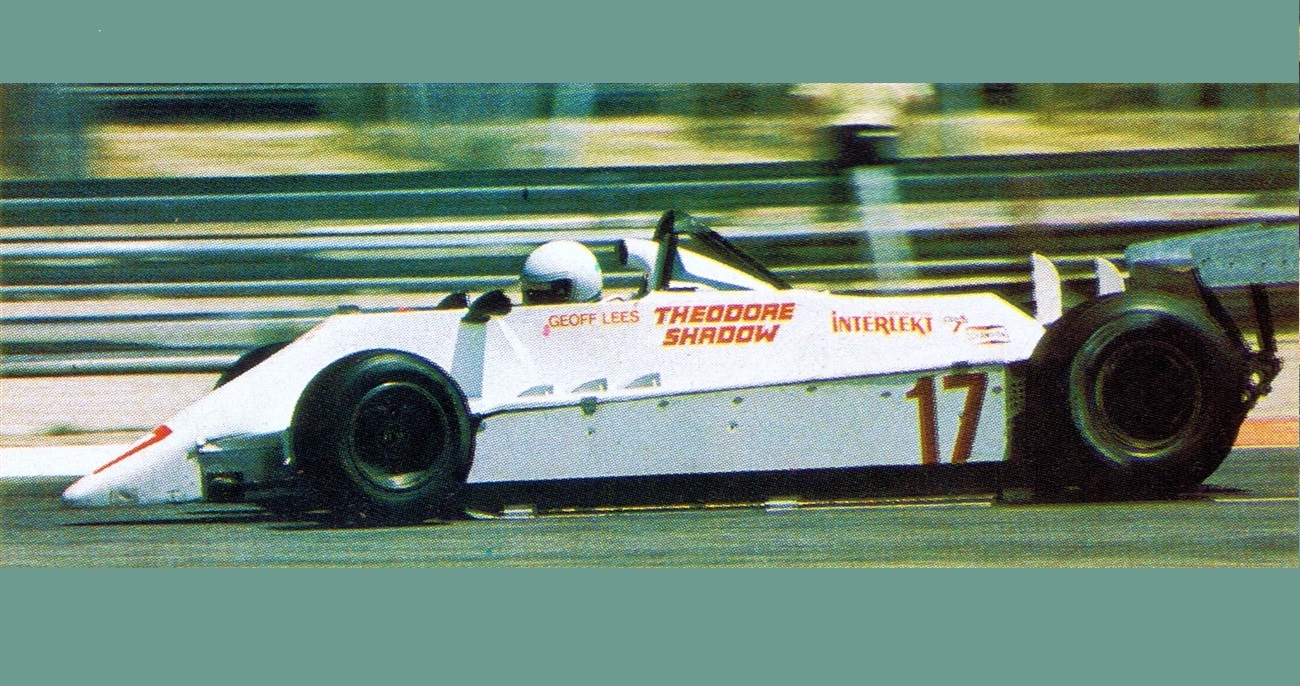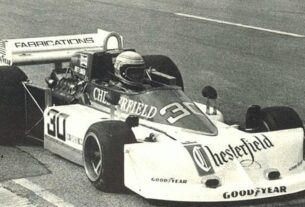Once the Formula One was the playground for engineering weirdness and excellence. The best idea’s emerge during the 1960s, 1970s and 1980s. Tyrrell designed the P34, the well-known six-wheeler. Lotus came with the ground effect, and Renault came with the first Turbo engine. There, and there came Lion Grand Prix. A formula 1 car with twelve wheels and powered by a turbine engine! The brainchild of late David Cox.
How unrealistic it may seems, the plan for the 12 wheeler F1 car were the real deal. I agree, it sounds like an idea that was created in a bar after a few pints. Though, David Cox was serious about the Lion Grand Prix car. Perhaps you know David Cox, he was the person that came with the addition on the Brabham BT46 in 1978 as the car suffered cooling problems. Indeed the Brabham BT46B Fan car!
I already mentioned David Cox, though to understand the Lion Grand Prix idea you need to know more about him. David was an engineer born on the 31th of May 1942 in Aylesbury, Buckinghamshire in The United Kingdom. Up to 1966 he went to several schools, though he understood he was not born to be the fulltime student. Instead he decided to learn everything himself. From that decision David worked mostly as a freelance engineer focused on engines. In 1966 he made his first noteworthy design in the auto sport. David purchased an ex-works Hillman Imp and he designed a turbo charged engine for the car.
A few weeks after his creation he came in contact with former F1 driver and constructor Paul Emery. Paul was impressed by David his work and offered him a job as development engineer and a seat in the BTCC. In the years to come David would develop a new engine for the F5000 (Kitchmac) and several V8 engines such as the Rover and Rolls-Royce. He did some racing was well in the late 60s and early 70s with Austin and Bugatti on Brooklands. Eventually he ended up racing in the Group 1 with his own Maztar Rotary Saloon.
His first steps in the Formula One were in November 1970 when he came in contact with Frank Williams, via his friend Jack Knight. With the sponsorship of Politoys Frank Williams Racing Cars would race with the March 701 and the March 711. Frank Williams asked David to come over for an interview for the position of Chief Designer. When Frank heard that David at that time only had designed some composite wheels for the F5000 it was thank you and goodbye. David wrote in his CV that he and Frank and a couple of laughs years after about the interview. And with Patrick Head the team had eventually a good second choice!
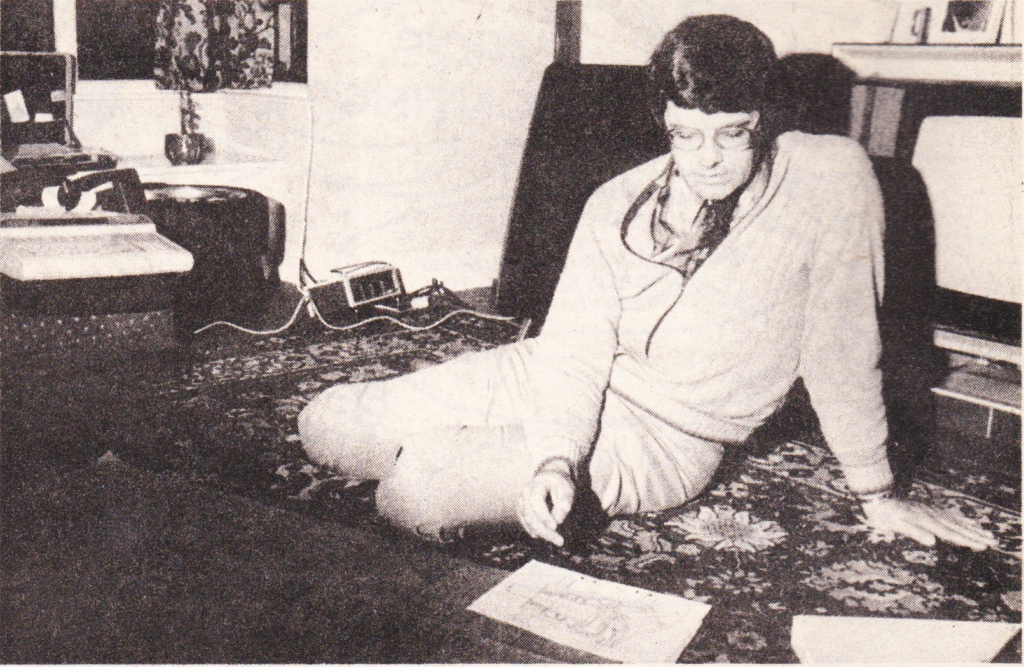
David Cox 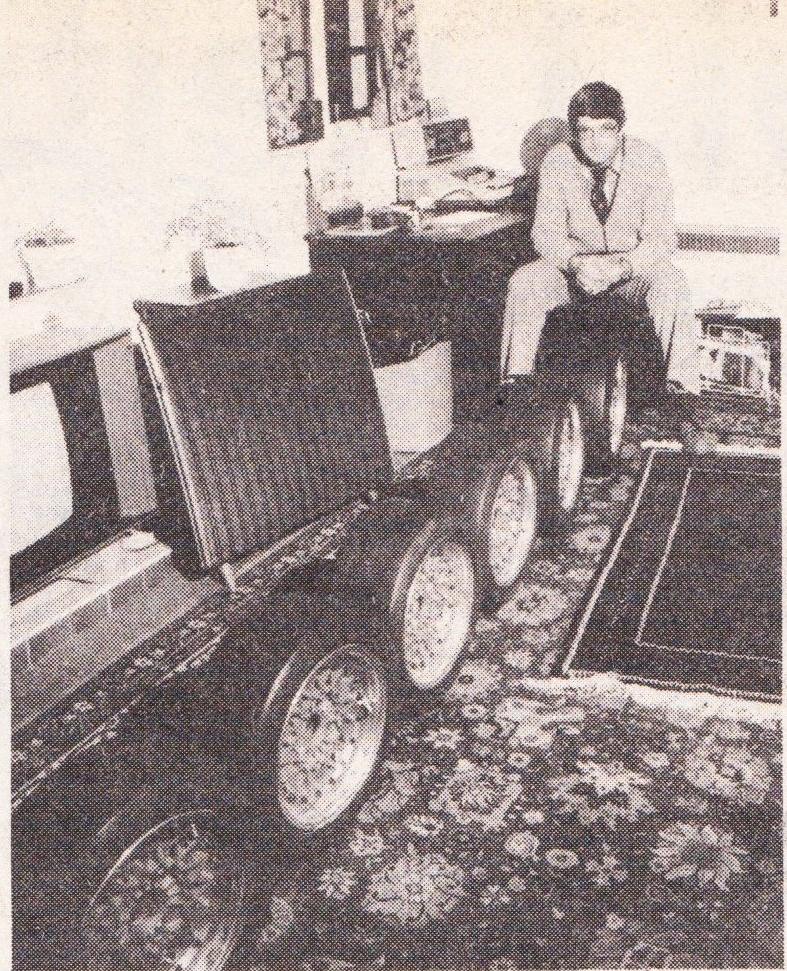
David Cox
In 1977 he came in contact with the General Manage of the Brabham F1 Team. At that time F1 supremo Bernie Eccelstone’s team. He came up with several idea’s for the team’s car. However, in first instance they did not seem to take his idea’s serious. Though the Brabham BT46 had the toy-tag method applied on the car. Eventually, David Cox would design the Brabham BT46B fan car. After Brabham encountered cooling issues while testing at Alfa Romeo’s test circuit Balocco. The car won his first race at Anderstorp. It would be the only race for the Brabham BT46B, as the FIA would ban the car.
In 1981 Teddy Meyer, McLaren Team Boss, contacted David Cox if he was available to work on several advanced projects for the team. During his second interview Ron Dennis was also presented. At that time he was to take over the team. During the second interview David came with the idea of the implementation of DAF’s CVT technology to develop and implement for the McLaren tea in 1982. Ron Dennis the idea was to expensive at that time, while 55.000 pounds was calculated for it. The same time David asked Peter Wright, technical director of Team Lotus, if he could implement the CVT technology in their simulator. The results were pretty good. Williams would test with the system 12 years later!
In 1979, at the age of 37, David Cox started to work in his innovative and unseen Formula 1 concept. A Formula One car powered by a turbine engine and fitted with twelve wheels, which 10 of them would have a steering function. The plan for the Lion Grand Prix car were born. The question you should ask yourself, why twelve wheels? It seems pretty much futuristic together with the turbine engine. A crazy idea? Perhaps! Though, it show the creativity of someone.
Let’s answer the question why 12 wheels, by using the document David Cox created for the presentation named “Why 12 wheels”.
– As the concept is new in the Formula 1 it generates more publicity which is more interesting for potential sponsors.
– Because there is more room for sponsorship, as on the wheels for example, more sponsors can be attracted. Or sponsors can add more sponsorship at the car.
– The 12 wheels reduce the car’s drag coefficient from 0,8 to 0,65.
– When you use 12 wheels on the car thereby increase the terminal speed from 281km/h to 328km/h with the same amount of power.
– The overall width of the car would be reduced from 2150mm to 1886mm compared to the Formula 1 cars that raced at that time. As well adapted to the new Formula One rules.
– Because the car will use 12 wheels it fills in the space normally found amidships between the wheels of a Formula One car. Hence preventing the wheels of closely competing cars from interlocking with possible disastrous consequences.
– The monocoque provides an extra 20cm of crushable structure down to each side of the car. It’s more than the requestion crushable structure than the Formula one had in their regulations.
– The speed of the car would increase when aquaplaning sets in on rain-soaked track. The total amount of water the car would get ride off would be 59%.
Tyres
Lion Grand Prix would use Formula 3 sized tyres. These tyres were smaller than the Formula 1 tires used in 1980. Several factors showed the effort would be better to use these tyres. The front of the car could be reduced by 23%. As well the car would use more of the surface of the tyres on the track. Which would results in a better grip. They wheels were to be made of Fibre Reinforced Plastic (FRP). According to the documentation both Dunlop and Firestone did test with these tyres in 1979, a so called destruction speed test was held before. Dunlop or Firestone would most likely deliver the tyres.
Technique of the Lion Grand Prix
The technique under need the body was much different from the conventional cars un late 1970 early 1980s. The car would be fitted with 12 tyres, which 10 of them would have a steering function. All the tyres would be individually controlled, every wheel would have its own hydrostatic engine. Which was connected to the gas turbine. The suspension would be fitted with the inter-linked air suspension. The inter-linked would be controlled, individually, by microprocessors. This system was capable to overcome the power on the suspension. A controversial suspension would not be able to do this. The system was eventually easy to maintain and if needed to replace the system. Volvo at that time already used a similar system on their road cars.
Engine / Transmission of the Lion Grand Prix
The Lion Grand Prix car would use a turbine engine. The idea of a turbine engine in the Formula On was not a new concept. Years before in 1968 the Lotus 56 STP was fitted with a Turbine engine. The car was fitted with a Pratt & Whitney gas turbine engine. The car was entered for the 1968 indy 500. In 1971 the Lotus 58B appeared on the grid mostly at non-championship races to test the cars performance. Emerson Fittipaldi and Reine Wisell drove a couple of times with the Lotus56B. Though only Fittipaldi manage to finish the car once as 8th during the Italian Grand Prix.
In 1979, years later, David Cox contacted a couple manufactures of turbine engines. All of them made the engines for helicopters. According to the presentation he made for the Lion Grand Prix there were two American companies requested to make a quotation with several type of engines. Though, it is more likely that Hants & Sussex from Portsmouth would deliver the turbine engine. On the 1st of July 1979 the company did send a quotation to David Cox. The quotation can be seen in the documentation as well below here.
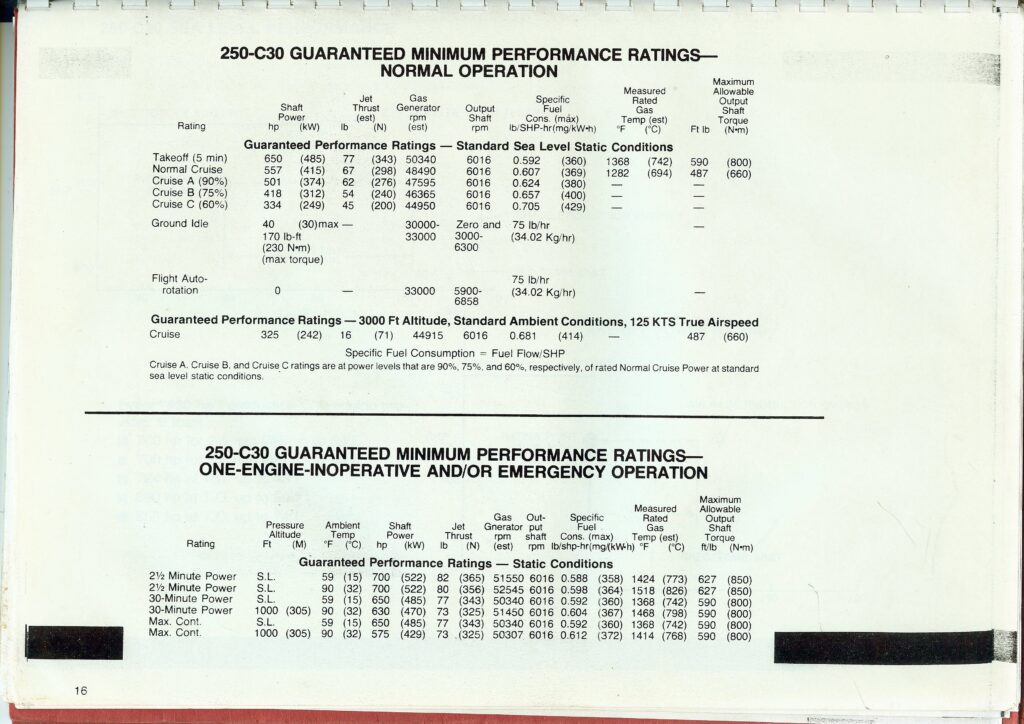
Allison turbine 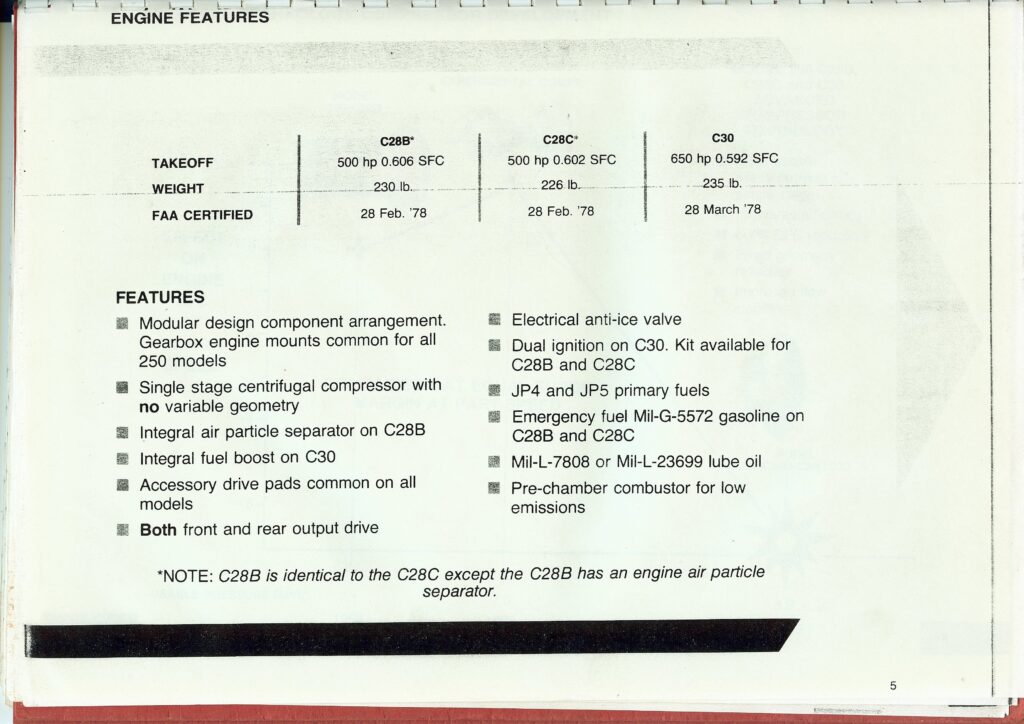
Allison turbine
Hants & Sussex had a brand-new turbine engine the Allison All-model 250. Which had six different types. Interesting to see is the price difference from the six versions. For the Lion Grand Prix car the focus was on the model 250-C28B and the more expensive model 250-C30. The main focus was the amount of power and weight. Compared to the popular Cosworth DFV engine, it was 77 kilo lighter. Amount of fuel that would be use was similar to the DFV engine as well. The difference was the usage of fuel. The Alison engine would use kerosine. Despite Kerosine is 11% heavier per litre than the usual fuel.
According to David Cox’s his calculations the average of energy getting out of Kerosine was 5% more than with the ordinary fuel. The Allison turbine engine would deliver around 650 HP. There is only one problem with the Turbine engines. The lag. Cox solved this for the Lion Grand Prix car. The lag would be conquered by storing the rotating energy in the “Free power take-off turbine part”. As well the configuration of a higher idle speed in the turbine gas generators.
Design of the Lion Grand Prix car
There was no similarity between the Lion Grand Prix Car and the regular design that was used in the late 1970s and early 1980s. The car looked more like an slim arrows with no wings applied to the car. The front of the car has some of aggressive look which applies to the car. David Cox was convinced that his design would be on his best with a so called suction concept to generate downforce. More or less, forgive me if not correctly written, the car was to be sucked to the ground due to the form of the car. I have no clue how the concept exactly works. I’m not having enough know how to explain it correctly.
The engine cover of the Alison turbine was pretty aerodynamically designed within the chassis. If you study the prints of the car with several sponsors on it. To get a good view of the size of the Lion Grand Prix an eye view was penned by David Cox. The Lion Grand Prix car and Williams FW07 were penned in it. The Lion Grand Prix is more compact than the Williams FW07.
Steering with the Lion Grand Prix car
Steering the car would be completely different from the normal Formula 1 cars. The cars used to have a steering wheel though this car would not. The cockpit had the feeling of some semi-modern cockpit of an airplane. You may have an idea how the steering would be. The driver of the car would be cross legged or leg crossed sitting in the car. The feet placed to the sides of the monocoque. Im not sure if this can be comfortable for the driver during racing. Neither had the car pedals, all the driver would was a joystick they had to use to steer the car with. The joystick would be in the form of a round steering-wheel.
The car would probably be started by a starting button. To start driving all you had to do was to pull the steering column 25mm or 2,5cm towards the driver. If the driver needs to use the breaks the driver had to push the steering column 25mm or 2,5cm. The weight of the arms and the force of the muscles would act as servo-support. To turn the wheels you turned the wheel to the left or to the right as normally.
Some more information about the braking-system. To brake you have to push the steering column. On the column would be a meter fitted which showed the pneumatic pressure in the pipes. “Which could reach up to 21,000psi. A maximum pressure of 2,2G would be on the brakes.
Some futuristic stuff on the Lion Grand Prix car
What completes the car is the amount of sponsoring available. The wheel covers can be used for sponsorship, as you can see on the penned Lion Grand Prix car with sponsorship on it. The engine cover, which is bigger than the average Formula one car, gains even more space for sponsors on the car.
There were even plans to adapt some sort of led screens on the cars side. This would mean that sponsors could apply animated sponsoring and slogans for the people around the track. As well there would be a option to apply speakers on the car. Sponsors would be able to let the fans hear their jingles and messages they would share. Its something you only hear from the speakers that are around the circuit. Wouldn’t that be amazing if it came from a Formula One car?
Than there was also the idea when the Lion Grand Prix car was build and it was time to test with the car. That they would everything from the test session and eventually broadcast it with fans all around the world. The LCD screens are applied only the last few years in the Formula 1 to show sponsors on it.
The Cost for the Lion Grand Prix Team
Perhaps the best part of the documentation that David Cox made for the Lion Grand Prix car was the overview of the costs for the team. How much the costs would be for the engine, for the employees, for spare-parts, to design, to build the car and so on. David Cox was serious with his attempt to bring the 12-wheeler alive.
The original plans, this you can conclude from the documents, to bring two cars every Grand Prix weekend. There would be one race car and one T-car, back then teams were allowed to have a spare car in the garage. Probably the cars would be numbers DC001-01 (David Cox 001- Chassis 01) and DC001-02. A third chassis would be built as well, perhaps to upgrade the team to a two cars team. The costs for a full season would be 713.000 pound. Around twenty people would working for the team.
As far as known there was no company already interested in the team, and was to sponsor the project. Though if you read David Cox’s his CV there were some big companies that were ready to invest in the team. Barclay’s international and GM (General motors) were mentioned. David Cox made multiple examples of how the sponsoring could be applied on the chassis. Cars with sponsoring of Rothmans, Rover, Midland Bank, Volvo, Barclays and even one with Marlboro were made. David Cox his daughter, Diana who send me the documentation about the Lion Grand Prix project, told me that an old business partner named Nick was looking for sponsors in 1979 and 1980. A lot of efforts were made to gain the finance which was needed for the car.
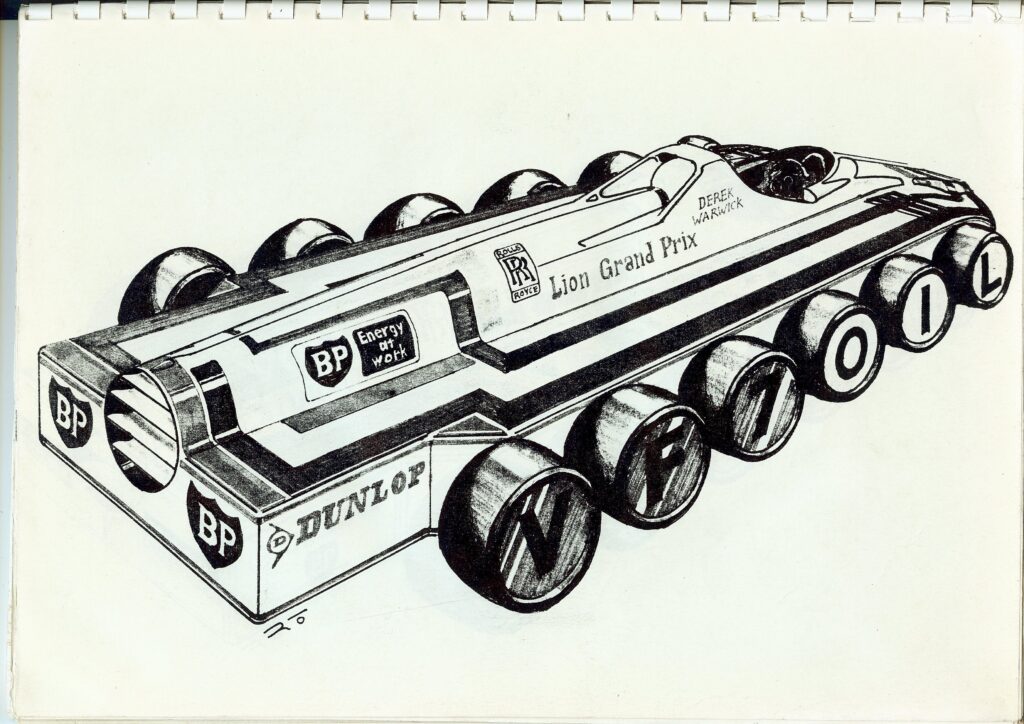
Derek Warkwick as driver? 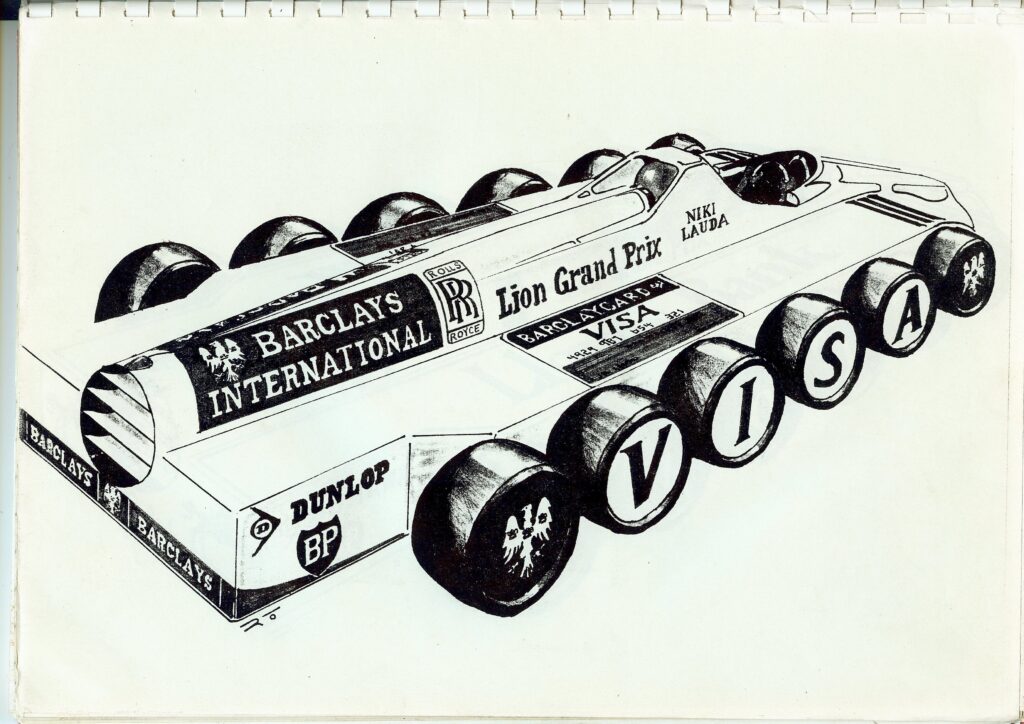
Niki Lauda as driver?
The Drivers
Absolutely nothing is known about the drivers. However, if you look at the examples with the sponsorship there are two names written on the car. Niki Lauda and Derek Warwick. Interesting to see is Warwick his name on the car. In 1979 he drove a couple of races in the Aurora F1 Championship series and in the European Formula 2 championship. In both series with a Theodore. If Niki Lauda and Derek Warwick have ever been contacted for a drive is unknown. I asked Derek about it, though I received no answer about it so far.
Was David Cox a genius or was he insane when appeared with the Lion Grand Prix project? If you ask me David was a genius. If you read his CV carefully you basically see a big part of his life. What he accomplished how he dared to take steps others wouldn’t. As well if you read his article in Autosport January 1980 about the Lion Grand Prix car, you just feel the pure passion. After the Lion Grand Prix project basically folded David kept on continue working and developing on racing engines. In the late 1990s David Cox, together with Dan Eagle, designed a brand new V10 Formula one engine.
The engine was send to the FIA to be applied as a engine to be used by teams. The FIA changed the rules, which meant the engine would be useless. After this attempt David focused on Outboard engines for boats. The company he started, a few years before he passed away, still exists today you can visit the company here.
What many don’t know. David Cox was also working on a twelve wheeler sports car. A limited edition of this car would be build. The 12-wheeler sports car would have been more comfortable to drive in. If you look at the idea there is place for two people in it, though the car is pretty long. It could be more people could take place in it. As well the steering system would be the same as for the Lion Grand prix car.
Sadly David Cox passed away a couple of years ago. Though im grateful that Diana, David’s daughter, contacted me on twitter when I posted the Autosport interview with David Cox. She provided me the documentation about the Lion Grand Prix car. As well his CV. This article has been written in dedication of David Cox. An engineer not many seem to remember.

